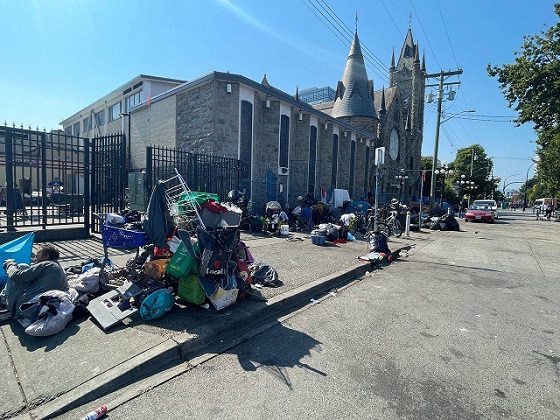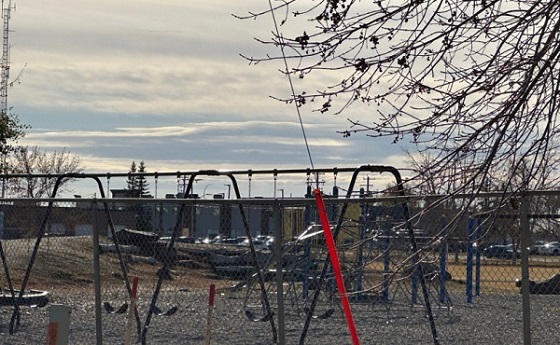Addictions
B.C. mayors voice discontent over province’s response to drug crisis

The street outside the Harbour Supervised Consumption Service in Victoria, B.C., on Sept. 6, 2024. (Photo credit: Alexandra Keeler)
By Alexandra Keeler
A number of B.C. mayors say the province’s drug decriminalization project has been a failure — and they are not confident involuntary care will address the problem
Many B.C. mayors are unhappy with the province’s handling of the drug crisis, saying it is failing their communities.
“I don’t think [the province’s] approach was very well thought out,” said Mayor Brad West of Port Coquitlam, a city of 61,000 that is a half-hour’s drive east of Vancouver.
“They announced, seemingly pretty quickly, that the province was going to pursue decriminalization, and there didn’t seem to be a lot of public discourse or consultation in the lead up to it,” he said.
“It was just kind of like, ‘Bam! Here it is.’”
West’s comments were echoed by other municipal leaders, who also say the province’s harm-reduction and treatment services are under-resourced, leaving them ill-equipped to help community members who are struggling.
‘Can’t do anything’
West says he and Port Coquitlam’s constituents observed an immediate increase in public drug use after the province launched a three-year, trial decriminalization project in January 2023.
The project initially enabled residents to use otherwise illicit drugs — such as fentanyl, heroin and cocaine — in most parts of the province, although it prohibited drug use on school premises or near child-care facilities.
Yet, West says drug use in parks and playgrounds was a major issue in his community.
“What [decriminalization] meant in a place like Port Coquitlam is that when you did have an incident that required a police response, none was forthcoming anymore,” he said. “[Police] would tell you, ‘Well, we can’t do anything. We’re not allowed to.’”
In June 2023, Port Coquitlam responded by passing a bylaw, introduced by West, that banned drug use in public spaces. Other B.C. municipalities — including Nelson, Kamloops and Campbell River — soon followed suit.
In December, B.C. tried to pass a law enabling police to remove people from public spaces if they were using drugs. But a B.C. court temporarily blocked it, citing risks to drug users.
The province then sought approval from Ottawa to re-criminalize public drug use, which it obtained this spring. Now, hard drug use is only permitted in private residences, legal shelters or harm-reduction clinics.
Subscribe for free to get BTN’s latest news and analysis, or donate to our journalism fund.
Wait times
West says he has also been frustrated with the province’s harm-reduction facilities, which he describes as “poorly staffed” and “under-resourced.” These facilities often fail to connect individuals to necessary resources or recovery programs, he says.
West has witnessed some of these problems up close. His stepbrother battled addiction and homelessness before finding recovery.
“The biggest barrier that I think he encountered — and most people encounter in terms of recovery — is the wait times,” he said.
The wait time to get into B.C.’s private addiction rehab centres is about three to seven days. But the cost — ranging from $10,000 to $30,000 a month — is out of reach for many.
By contrast, the wait time to get into government-funded programs is about three to six months.
In addition to advocating for more accessible recovery services, West emphasizes the need for stronger enforcement at docks, ports and borders to combat drug trafficking.
“Our ports of entry, our border, the port itself, are completely porous,” he said. “We have no dedicated port police — one of the few jurisdictions that doesn’t. And as a result, Metro Vancouver has become an epicentre for drug trafficking.”
In May 2023, he was the sole Canadian mayor invited by US Secretary of State Antony Blinken to discuss the issue with other mayors. “We have weak [drug] laws … This is why I think we’ve become a global hub for [drug trafficking],” he said.
Brain damage
The BC NDP and BC Conservatives have both recently pledged to introduce involuntary care, which would enable the province to admit people with addiction challenges, brain injuries and mental-health issues into treatment facilities without their consent.
Mayor Leonard Krog of Nanaimo, a coastal city of about 100,000 on the east side of Vancouver Island, has long advocated for involuntary care.
 |
Nanaimo Mayor Leonard Krog sits in his office at Nanaimo City Hall on Sept. 4, 2024. (Photo credit: Alexandra Keeler)
Krog notes that a significant segment of the homeless population has suffered brain damage, which can exacerbate efforts to help them. A 2020 report by Brain Injury Canada says about 50 per cent of people experiencing homelessness have some form of brain injury.
Krog does not believe people with brain injuries and addiction issues are likely to seek treatment on their own. “Those folks should be in secure, involuntary care,” he said.
But he is not optimistic that NDP’s involuntary care proposal will address the full scope of the issue.
“[I]n terms of numbers, my strong view is that it will not address the significant population who are currently in the streets.”
Stay alive
Victoria Mayor Marianne Alto believes in providing support to keep people alive until they seek recovery.
“My view of harm reduction is … I’ll give you anything you need to stay alive until you have that epiphany moment,” she said.
But she is concerned that the province has not adopted a comprehensive approach to tackling the drug crisis. The recent proposals to introduce involuntary care have not eased her concerns.
“Involuntary care can be a necessary tool in a complex system,” she said. “But its effectiveness hinges on clear standards. We must ensure that individuals receive not just initial intervention but also ongoing support to prevent their return to the circumstances that led them there.”
“The devil is in the details,” she said.
 |
Victoria Mayor Marianne Alto leans against a railing in downtown Victoria, B.C. , in May 2022. (Marianne Alto’s Facebook)
The B.C. capital has been pursuing additional strategies to tackle the city’s homelessness, addiction and mental health challenges.
For example, a local nonprofit has been working with individuals living in parks to connect them with housing and support. “It’s also very slow, because to be very successful, you have to do it one person at a time, one-on-one. But it’s working,” she said.
But other efforts have met resistance.
City council rejected a motion introduced by Alto that had proposed rewarding churches and cultural centres that offered overnight parking to vehicle-dwelling homeless people. Five council members opposed it, Alto says, citing fears about crime and concerns that the program overstepped their duties.
“There is a genuine fatigue in the public, which is being reflected in municipal councils, saying, ‘How much further, how much longer, how much more?’”
This article was produced through the Breaking Needles Fellowship Program, which provided a grant to Canadian Affairs, a digital media outlet, to fund journalism exploring addiction and crime in Canada. Articles produced through the Fellowship are co-published by Break The Needle and Canadian Affairs.
You’re currently a free subscriber to Break The Needle. Our content is always free – but if you want to help us commission more high-quality journalism, consider getting a voluntary paid subscription.
Addictions
Canadian gov’t not stopping drug injection sites from being set up near schools, daycares

From LifeSiteNews
Canada’s health department told MPs there is not a minimum distance requirement between safe consumption sites and schools, daycares or playgrounds.
So-called “safe” drug injection sites do not require a minimum distance from schools, daycares, or even playgrounds, Health Canada has stated, and that has puzzled some MPs.
Canadian Health Minister Marjorie Michel recently told MPs that it was not up to the federal government to make rules around where drug use sites could be located.
“Health Canada does not set a minimum distance requirement between safe consumption sites and nearby locations such as schools, daycares or playgrounds,” the health department wrote in a submission to the House of Commons health committee.
“Nor does the department collect or maintain a comprehensive list of addresses for these facilities in Canada.”
Records show that there are 31 such “safe” injection sites allowed under the Controlled Drugs And Substances Act in six Canadian provinces. There are 13 are in Ontario, five each in Alberta, Quebec, and British Columbia, and two in Saskatchewan and one in Nova Scotia.
The department noted, as per Blacklock’s Reporter, that it considers the location of each site before approving it, including “expressions of community support or opposition.”
Michel had earlier told the committee that it was not her job to decide where such sites are located, saying, “This does not fall directly under my responsibility.”
Conservative MP Dan Mazier had asked for limits on where such “safe” injection drug sites would be placed, asking Michel in a recent committee meeting, “Do you personally review the applications before they’re approved?”
Michel said that “(a)pplications are reviewed by the department.”
Mazier stated, “Are you aware your department is approving supervised consumption sites next to daycares, schools and playgrounds?”
Michel said, “Supervised consumption sites were created to prevent overdose deaths.”
Mazier continued to press Michel, asking her how many “supervised consumption sites approved by your department are next to daycares.”
“I couldn’t tell you exactly how many,” Michel replied.
Mazier was mum on whether or not her department would commit to not approving such sites near schools, playgrounds, or daycares.
An injection site in Montreal, which opened in 2024, is located close to a kindergarten playground.
Conservative Party leader Pierre Poilievre has called such sites “drug dens” and has blasted them as not being “safe” and “disasters.”
Records show that the Liberal government has spent approximately $820 million from 2017 to 2022 on its Canadian Drugs and Substances Strategy. However, even Canada’s own Department of Health admitted in a 2023 report that the Liberals’ drug program only had “minimal” results.
Recently, LifeSiteNews reported that the British Columbia government decided to stop a so-called “safe supply” free drug program in light of a report revealing many of the hard drugs distributed via pharmacies were resold on the black market.
British Columbia Premier David Eby recently admitted that allowing the decriminalization of hard drugs in British Columbia via a federal pilot program was a mistake.
Former Prime Minister Justin Trudeau’s loose drug initiatives were deemed such a disaster in British Columbia that Eby’s government asked Trudeau to re-criminalize narcotic use in public spaces, a request that was granted.
Official figures show that overdoses went up during the decriminalization trial, with 3,313 deaths over 15 months, compared with 2,843 in the same time frame before drugs were temporarily legalized.
Addictions
Canada is divided on the drug crisis—so are its doctors

When it comes to addressing the national overdose crisis, the Canadian public seems ideologically split: some groups prioritize recovery and abstinence, while others lean heavily into “harm reduction” and destigmatization. In most cases, we would defer to the experts—but they are similarly divided here.
This factionalism was evident at the Canadian Society of Addiction Medicine’s (CSAM) annual scientific conference this year, which is the country’s largest gathering of addiction medicine practitioners (e.g., physicians, nurses, psychiatrists). Throughout the event, speakers alluded to the field’s disunity and the need to bridge political gaps through collaborative, not adversarial, dialogue.
This was a major shift from previous conferences, which largely ignored the long-brewing battles among addiction experts, and reflected a wider societal rethink of the harm reduction movement, which was politically hegemonic until very recently.
Recovery-oriented care versus harm reductionism
For decades, most Canadian addiction experts focused on shepherding patients towards recovery and encouraging drug abstinence. However, in the 2000s, this began to shift with the rise of harm reductionism, which took a more tolerant view of drug use.
On the surface, harm reductionists advocated for pragmatically minimizing the negative consequences of risky use—for example, through needle exchanges and supervised consumption sites. Additionally, though, many of them also claimed that drug consumption is not inherently wrong or shameful, and that associated harms are primarily caused not by drugs themselves but by the stigmatization and criminalization of their use. In their view, if all hard drugs were legalized and destigmatized, then they would eventually become as banal as alcohol and tobacco.
The harm reductionists gained significant traction in the 2010s thanks to the popularization of street fentanyl. The drug’s incredible potency caused an explosion of deaths and left users with formidable opioid tolerances that rendered traditional addiction medications, such as methadone, less effective. Amid this crisis, policymakers embraced harm reduction out of an immediate need to make drug use slightly less lethal. This typically meant supervising consumption, providing sterile drug paraphernalia, and offering “cleaner” substances for addicts to use.
Many abstinence-oriented addiction experts supported some aspects of harm reduction. They valued interventions that could demonstrably save lives without significant tradeoffs, and saw them as both transitional and as part of a larger public health toolkit. Distributing clean needles and Naloxone, an overdose-reversal medication, proved particularly popular. “People can’t recover if they’re dead,” went a popular mantra from the time.
Saving lives or enabling addiction?
However, many of these addiction experts were also uncomfortable with the broader political ideologies animating the movement and did not believe that drug use should be normalized. Many felt that some experimental harm reduction interventions in Canada were either conceptually flawed or that their implementation had deviated from what had originally been promised.
Some argued, not unreasonably, that the country’s supervised consumption sites are being mismanaged and failing to connect vulnerable addicts to recovery-oriented care. Most of their ire, however, was directed at “safer supply”—a novel strategy wherein addicts are given free drugs, predominantly hydromorphone (a heroin-strength opioid), without any real supervision.
While safer supply was meant to dissuade recipients from using riskier street drugs, addiction physicians widely reported that patients were selling their free hydromorphone to buy stronger illicit fentanyl, thereby flooding communities with diverted opioids and exacerbating the addiction crisis. They also noted that the “evidence base” behind safer supply was exceptionally poor and would not meet normal health-care standards.
Yet, critics of safer supply, and harm reduction radicalism more broadly, were often afraid to voice their opinions. The harm reductionists were institutionally and culturally dominant in the late 2010s and early 2020s, and opponents often faced activist harassment, aggressive gaslighting, and professional marginalization. A culture of self-censorship formed, giving both the public and influential policymakers a false impression of scientific consensus where none actually existed.
The resurgence in recovery-oriented strategies
Things changed in the mid-2020s. British Columbia’s failed drug decriminalization experiment eroded public trust in harm reductionism, and the scandalous failures of safer supply—and supervised consumption sites, too—were widely publicized in the national media.1
Whereas harm reductionism was once so powerful that opponents were dismissed as anti-scientific, there is now a resurgent interest in alternative, recovery-oriented strategies.
These cultural shifts have fuelled a more fractious, but intellectually honest, national debate about how to tackle the overdose crisis. This has ruptured the institutional dominance enjoyed by harm reductionists in the addiction medicine world and allowed their previously silenced opponents to speak up.
When I first attended CSAM’s annual scientific conference two years ago, recovery-oriented critics of radical harm reductionism were not given any platforms, with the exception of one minor presentation on safer supply diversion. Their beliefs seemed clandestine and iconoclastic, despite seemingly having wide buy-in from the addiction medicine community.
While vigorous criticism of harm reductionism was not a major feature of this year’s conference, there was open recognition that legitimate opposition to the movement existed. One major presentation, given by Dr. Didier Jutras-Aswad, explicitly cited safer supply and involuntary treatment as two foci of contention, and encouraged harm reductionists and recovery-oriented experts to grab coffee with one another so that they might foster some sense of mutual understanding.2
Is this change enough?
While CSAM should be commended for encouraging cross-ideological dialogue, its efforts, in this respect, were also superficial and vague. They chose to play it safe, and much was left unsaid and unexplored.
Two addiction medicine doctors I spoke with at the conference—both of whom were critics of safer supply and asked for anonymity—were nonplussed. “You can feel the tension in the air,” said one, who likened the conference to an awkward family dinner where everyone has tacitly agreed to ignore a recent feud. “Reconciliation requires truth,” said the other.
One could also argue that the organization has taken an inconsistent approach to encouraging respectful dialogue. When recovery-oriented experts were being bullied for their views a few years ago, they were largely left on their own. Now that their side is ascendant, and harm reductionists are politically vulnerable, mutual respect is in fashion again.
When I asked to interview the organization about navigating dissension, they sent a short, unspecific statement that emphasized “evidence-based practices” and the “benefits of exploring a variety of viewpoints, and the need to constantly challenge or re-evaluate our own positions based on the available science.”
But one cannot simply appeal to “evidence-based practices” when research is contentious and vulnerable to ideological meddling or misrepresentation.
Compared to other medical disciplines, addiction medicine is highly political. Grappling with larger, non-empirical questions about the role of drug use in society has always necessitated taking a philosophical stance on social norms, and this has been especially true since harm reductionists began emphasizing the structural forces that shape and fuel drug use.
Until Canada’s addiction medicine community facilitates a more robust and open conversation about the politicization of research, and the divided—and inescapably political—nature of their work, the national debate on the overdose crisis will be shambolic. This will have negative downstream impacts on policymaking and, ultimately, people’s lives.
Our content is always free – but if you want to help us commission more high-quality journalism,
consider getting a voluntary paid subscription.
-

 Agriculture1 day ago
Agriculture1 day agoBovaer Backlash Update: Danish Farmers Get Green Light to Opt Out as UK Arla Trial Abruptly Ends!
-

 International1 day ago
International1 day agoBBC boss quits amid scandal over edited Trump footage
-

 Alberta1 day ago
Alberta1 day agoSchool defunding petition in Alberta is a warning to parents
-

 Daily Caller1 day ago
Daily Caller1 day agoMcKinsey outlook for 2025 sharply adjusts prior projections, predicting fossil fuels will dominate well after 2050
-

 Agriculture1 day ago
Agriculture1 day agoFarmers Take The Hit While Biofuel Companies Cash In
-

 Business16 hours ago
Business16 hours agoCarney’s Floor-Crossing Campaign. A Media-Staged Bid for Majority Rule That Erodes Democracy While Beijing Hovers
-

 Frontier Centre for Public Policy1 day ago
Frontier Centre for Public Policy1 day agoNotwithstanding Clause Is Democracy’s Last Line Of Defence
-

 Business1 day ago
Business1 day agoCarney government needs stronger ‘fiscal anchors’ and greater accountability









